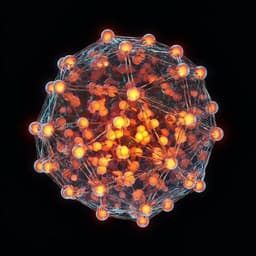
Engineering and Technology
Low-temperature strain-free encapsulation for perovskite solar cells and modules passing multifaceted accelerated ageing tests
P. Mariani, M. Á. Molina-garcía, et al.
Discover the groundbreaking encapsulation method for perovskite solar cells developed by an expert team. This innovative process not only reduces thermomechanical stress but also enhances thermal and barrier properties. The encapsulated devices succeeded in accelerated aging tests, maintaining over 80% efficiency—paving the way for stability and commercialization.
~3 min • Beginner • English
Introduction
Perovskite solar cells (PSCs) have reached high efficiencies (up to 26.1% single-junction and 33.9% tandem) and offer low-cost, scalable processing, but their long-term stability remains a barrier to achieving competitive levelized cost of energy versus crystalline silicon. At module scale, additional failure mechanisms (e.g., potential-induced degradation and reverse bias effects) and a combination of intrinsic (polymorphism, defects, lattice strain, ion migration) and extrinsic (moisture, oxygen, heat, UV, reverse bias) stressors drive degradation. Moisture and oxygen interact with perovskites to form volatile species and induce decomposition, while temperature and illumination accelerate intrinsic degradation. Encapsulation is thus critical for PSC/PSM lifetimes >20 years, but conventional PV encapsulants and processes do not fully meet PSC needs, which include chemical compatibility, very low water and oxygen transmission, UV resistance, low-temperature processability (≤120 °C), high optical transparency for front-side encapsulation, high electrical resistivity, and suitable mechanical compliance. There is a gap in reliable accelerated aging data beyond small-area cells and a need for industrially compatible, high-throughput encapsulation strategies that address thermal management and environmental safety (e.g., Pb sequestration) without introducing significant cell-to-module losses.
Literature Review
Established encapsulation for PV (glass/encapsulant/glass) has been adapted to PSCs using adhesives such as EVA, ionomers (Surlyn, Bynel, Jurasol), polyisobutylene (PIB), polyolefins, polyurethanes, and thermoplastic polyurethanes, often with edge sealants (PIB tapes, UV-curables, epoxies, silicones, glass frits). Small-area PSCs have passed accelerated protocols (IEC 61215 and ISOS), including damp heat and thermal cycling in select studies, but results for perovskite solar modules (PSMs) remain scarce, highlighting a commercialization gap. A recent fluorosilicone gel enabled room-temperature, non-destructive encapsulation of 1 cm² cells and a 25 cm² module that passed IEC 61215 damp heat using an epoxy edge sealant; however, broader aging (e.g., thermal cycling, light soaking) at module level was limited. Industrially compatible PSM encapsulation with systematic accelerated aging beyond outdoor demonstrations is rarely reported. Encapsulants for PSMs also need thermal management due to low perovskite thermal conductivity and Pb sequestration to mitigate environmental risks. Many reported stable devices use encapsulant areas larger than the photoactive area, which must be validated for practical, high-aperture designs.
Methodology
Encapsulant design and preparation: The study introduces a solvent- and strain-free, blanket-cover encapsulation based on low-molecular-weight homopolymer polyisobutylene (PIB; Mw ≈ 95,000), which behaves as a highly viscoelastic semi-solid/highly viscous liquid across −40 to +85 °C. A composite encapsulant (PIB:h-BN) incorporates 5 wt% few-layer hexagonal boron nitride flakes produced by industrial wet-jet milling (WJM). PIB resins (and PIB:h-BN) were prepared by dissolving PIB in toluene (1:1.5 w/w), adding dried WJM h-BN for composites, mixing in a planetary mixer, then doctor-blading onto 1 mm glass and drying (1 h RT + 15 h at 60 °C) to yield 600–700 µm films.
Encapsulation/lamination: PSCs and PSMs were encapsulated in a glass/encapsulant/glass stack via a low-temperature, differential-pressure laminator (90 °C peak; moderate vacuum ~1 mbar; top pressure ~30 mbar; heating/cooling ramps and 600 s hold at 90 °C). No edge sealants were used. For cells, flat metallic ribbons provided external contacts; for modules, screen-printed Ag busbars extended beyond encapsulant to avoid ribbons. Total encapsulation process time was <45 min.
Device architectures:
- Mesoscopic n–i–p PSCs (1 cm²) with FTO/c-TiO₂/graphene-incorporating m-TiO₂/Cs0.08FA0.80MA0.12Pb(I0.88Br0.12)3/PEAI/PTAA/Au; also variants with spiro-OMeTAD HTL and planar n–i–p with SnO₂ ETL; inverted p–i–n with PTAA HTL, PCBM ETL, PEACI passivation, and Cu electrode.
- Mesoscopic n–i–p PSMs: 5 series-connected cells (2 cm² each; total active 10 cm²) on 5.6 × 5.6 cm² FTO glass using P1–P2–P3 laser patterning; busbars screen-printed; Au back electrode; geometric fill factor ~91%.
Encapsulant characterization:
- Barrier/anticorrosion: Potentiodynamic anodic polarization (ASTM G5-14) on structural steel coated with PIB or PIB:h-BN (film ~60 µm) in 3.5 wt% NaCl; Tafel analysis for corrosion current and rate; corrosion inhibition efficiency calculation.
- WVTR: Calcium corrosion test in glass/encapsulant/glass configuration (electrical monitoring and UV–Vis transmittance of Ca film) simulating edge ingress.
- Thermal management: Infrared cooling tests on glass/PIB/glass and glass/PIB:h-BN/glass stacks heated to 90 °C then cooled on Al plate; time to reach 30 °C compared.
- Adhesion and wettability (for solid, high-Mw PIB analogs): Water contact angle; pull-off adhesion (ASTM D4541-02) to assess effects of h-BN addition (not feasible on semi-solid/liquid films).
Accelerated aging and stability protocols:
- ISOS-D-1 preconditioning (240 h, dark, ambient) prior to tests.
- ISOS-D-2 (85 °C in dry oven) for >1000 h.
- ISOS-L-1 light soaking (>1000 h; MPP tracking; periodic JV).
- Customized thermal shock: 200 cycles with abrupt transitions between −40 °C and +85 °C; 20 min per cycle.
- Modified humidity freeze: 10 cycles beginning with water immersion at RT, then +85 °C and −40 °C transitions; 25 min per cycle.
- Pb leakage: ICP-OES of water after immersing PSMs (encapsulated vs unencapsulated) up to 24 h.
Optical tests for semi-transparent devices: UV–Vis transmittance and reflectance; AVT per ISO 9050:2003; JV under front/rear illumination; bifaciality factor.
Key Findings
- Encapsulant barrier and electrical properties: PIB exhibits high resistivity (~10^16 Ω·cm), exceeding EVA, favorable for suppressing potential-induced degradation. Both PIB and PIB:h-BN films drastically reduced steel corrosion rates from 0.73 mm·yr⁻¹ (bare steel) to averages of 1.5×10⁻⁴ and 1.7×10⁻⁴ mm·yr⁻¹, with minimums of 5.6×10⁻⁵ and 1.2×10⁻⁵ mm·yr⁻¹, respectively. Average corrosion inhibition efficiency reached 99.97% for PIB:h-BN and ~79.53% for homopolymer PIB.
- Moisture barrier: WVTR in glass/encapsulant/glass Ca-test configuration was ~2×10⁻⁵ g·m⁻²·day⁻¹ for both PIB and PIB:h-BN; Ca transmittance remained stable over 15 days, indicating negligible moisture ingress.
- Thermal management: PIB:h-BN stacks cooled faster, reducing time to reach 30 °C by 11.2% versus PIB, indicating improved heat dissipation; literature data suggest ~80% thermal conductivity enhancement in polymers with 5 wt% h-BN.
- Small-area PSC stability: Unencapsulated devices degraded rapidly with T50 <70 h (ISOS-D-2) and <5 h (ISOS-L-1). Encapsulated PSCs (PIB or PIB:h-BN) achieved T50 >1000 h in both tests, with negligible performance loss from lamination (absolute PCE drop <1%) and stable shelf-life over 240 h ISOS-D-1. Planar SnO₂ PSCs showed T80 ≈2000 h (encapsulated) vs 700 h (unencapsulated) in ISOS-D-2. Inverted p–i–n PSCs exhibited T80 >1000 h (encapsulated) vs <360 h (unencapsulated) in ISOS-D-2.
- Module (PSM) performance and stability: PSMs reached up to 17% PCE; encapsulation induced <1% absolute PCE loss and preserved performance over 240 h ISOS-D-1. Unencapsulated PSMs degraded with T80 <100 h (ISOS-D-2) and <3 h (ISOS-L-1), while encapsulated PSMs exhibited T80 >1000 h in both tests.
- Customized thermal shock and humidity freeze: After 200 thermal shock cycles (−40/+85 °C), PCE retention was 84.5% (PIB:h-BN) vs 82.1% (PIB). Following 10 modified humidity-freeze cycles, retention was 86.0% (PIB:h-BN) vs 72.1% (PIB), underscoring the added benefit of h-BN for barrier and thermal management.
- Lead leakage mitigation: Unencapsulated PSMs released >60 µg·cm⁻² Pb after 24 h immersion, while encapsulated PSMs showed <1 µg·cm⁻², with devices retaining perovskite phase/color and avoiding Au electrode cracking.
- Semi-transparent PSCs: PIB encapsulation increased AVT from 58.1% to 62.7% due to reduced reflectance and acted as an antireflective layer; encapsulated devices achieved PCE ~6.8% and bifaciality factor of 89% (vs 92% before encapsulation), with negligible performance loss upon lamination.
Discussion
The study addresses the key bottleneck of PSC/PSM stability by implementing a low-temperature, strain-free lamination of highly viscoelastic PIB-based encapsulants that mitigate thermomechanical stresses during both encapsulation and operation. The incorporation of h-BN flakes enhances barrier properties and heat dissipation, leading to superior resilience under multifaceted accelerated aging, including severe temperature shocks and humidity exposure without edge sealants. Demonstrating T50/T80 >1000 h in ISOS-D-2 and ISOS-L-1 tests for both cells and modules, along with strong performance in customized thermal shock and humidity freeze protocols, validates the encapsulation concept across cell architectures (n–i–p mesoscopic/planar and inverted p–i–n). The encapsulants also significantly reduce Pb release upon water exposure, addressing environmental concerns. For semi-transparent devices, PIB provides added optical benefits via reduced reflectance. Collectively, these outcomes show that semi-solid/liquid PIB-based encapsulation fulfills PSC-specific requirements (chemical compatibility, low WVTR/OTR, UV/thermal tolerance, high resistivity, mechanical compliance) and is compatible with industrial, high-throughput processes, bridging gaps between lab-scale stability demonstrations and practical module reliability.
Conclusion
A scalable, low-temperature blanket-cover encapsulation based on semi-solid/liquid PIB and PIB:h-BN composites effectively protects PSCs and PSMs without edge sealants, enabling them to pass multifaceted accelerated aging (ISOS-D1, D2, L1; thermal shock; modified humidity freeze) with >80% PCE retention. PIB’s viscoelasticity minimizes thermomechanical stress, while h-BN improves barrier and thermal management, yielding enhanced durability and reduced Pb leakage. The approach is universal across device architectures and supports semi-transparent applications with antireflective benefits. Future work could combine PIB-based encapsulants with optimized edge seals for extreme environments, apply MA-free perovskites for further intrinsic stability gains, refine encapsulant thickness via optical modeling to maximize transparency and PCE, and validate full IEC 61215 protocols on larger-area PSMs and higher-efficiency module designs.
Limitations
- Thermal conductivity of the semi-solid/liquid PIB-based encapsulants could not be directly measured due to the inability to form suitable self-standing bulk samples; thermal management benefits were inferred from cooling tests and literature analogs.
- The study employed customized thermal shock and modified humidity-freeze tests as rapid proxies rather than full-duration IEC 61215 thermal cycling and humidity freeze protocols.
- MA-containing perovskite compositions were used; while results are strong, further improvements are expected with MA-free chemistries.
- No edge sealants were used; while demonstrating strong primary encapsulant performance, combining with edge seals may further improve long-term robustness in field conditions.
Related Publications
Explore these studies to deepen your understanding of the subject.







